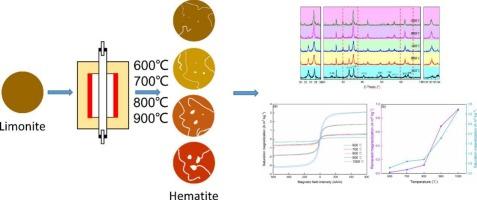褐铁矿磁化焙烧过程中微孔的形成及其影响
IF 4.5
2区 工程技术
Q2 ENGINEERING, CHEMICAL
引用次数: 0
摘要
作为一种丰富的铁矿石资源,褐铁矿(主要由鹅卵石、赤铁矿、鳞铁矿和其他铁矿物组成)因其成分复杂而很少被利用,导致其缺乏成熟的加工方法。磁化焙烧和磁选是一种很有前景的褐铁矿选矿方法。本文研究了微孔对褐铁矿还原焙烧的影响。采用 X 射线衍射、振动样品磁力仪、光学显微镜、扫描电子显微镜和表面积分析的 Brunauer-Emmett-Teller 法研究了脱羟机理。结果表明,当脱羟温度从 600 ℃ 升至 1000 ℃ 时,鹅辉石转变为赤铁矿,部分赤铁矿的晶体结构可能发生了变化,使样品的磁性增强,饱和磁化率从 0.29 A-m2-kg-1 显著增加到 3.20 A-m2-kg-1。同时,扫描电镜和 BET 显示焙烧后样品的表面性质有很大不同,随着温度的升高,孔隙越来越多,比表面积从 75.94 m2-g-1 下降到 0.59 m2-g-1。还原实验结果表明,脱羟温度对还原效率有显著影响,随着温度的升高,还原时间从 4 分钟增加到 12.5 分钟。该研究对使用磁化焙烧技术利用褐铁矿具有借鉴意义。本文章由计算机程序翻译,如有差异,请以英文原文为准。

Micropores formation and effects in the magnetization roasting of limonite ore
As an abundant iron ore resource, limonite (mainly composed of goethite, hematite, lepidocrocite and other iron minerals) ore is seldom utilized due to its complex compositions, which has led to it lack mature processing methods. Magnetization roasting and magnetic separation is a promising method to process limonite ore. In this paper, the influence of microscopic pores on the reduction roasting of limonite ore was studied. X-ray diffraction, vibrating sample magnetometry, optical microscope, scanning electron microscopy, and the Brunauer-Emmett-Teller method of surface area analysis were used to study the dehydroxylation mechanism. The results indicated that goethite transformed into hematite, and the crystal structure of partly hematite probably changed when the dehydroxylation temperature increased from 600 °C to 1000 °C, making the sample more magnetic, the saturation magnetization increases significantly from 0.29 to 3.20 A·m2·kg−1. Simultaneously, SEM and BET showed the surface property has a big difference after roasting, more and more pores were generated with the temperature increased, then the specific surface area of the sample decreased from 75.94 to 0.59 m2·g−1. The reduction experiment results showed the dehydroxylation temperature has a significant effect on the reduction efficiency, the reduction time increased from 4 to 12.5 min with the temperature increased. This study has implications for the utilization of limonite ore using magnetization roasting technology.
求助全文
通过发布文献求助,成功后即可免费获取论文全文。
去求助
来源期刊

Powder Technology
工程技术-工程:化工
CiteScore
9.90
自引率
15.40%
发文量
1047
审稿时长
46 days
期刊介绍:
Powder Technology is an International Journal on the Science and Technology of Wet and Dry Particulate Systems. Powder Technology publishes papers on all aspects of the formation of particles and their characterisation and on the study of systems containing particulate solids. No limitation is imposed on the size of the particles, which may range from nanometre scale, as in pigments or aerosols, to that of mined or quarried materials. The following list of topics is not intended to be comprehensive, but rather to indicate typical subjects which fall within the scope of the journal's interests:
Formation and synthesis of particles by precipitation and other methods.
Modification of particles by agglomeration, coating, comminution and attrition.
Characterisation of the size, shape, surface area, pore structure and strength of particles and agglomerates (including the origins and effects of inter particle forces).
Packing, failure, flow and permeability of assemblies of particles.
Particle-particle interactions and suspension rheology.
Handling and processing operations such as slurry flow, fluidization, pneumatic conveying.
Interactions between particles and their environment, including delivery of particulate products to the body.
Applications of particle technology in production of pharmaceuticals, chemicals, foods, pigments, structural, and functional materials and in environmental and energy related matters.
For materials-oriented contributions we are looking for articles revealing the effect of particle/powder characteristics (size, morphology and composition, in that order) on material performance or functionality and, ideally, comparison to any industrial standard.
 求助内容:
求助内容: 应助结果提醒方式:
应助结果提醒方式:


